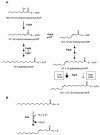Control of membrane lipid fluidity by molecular thermosensors
- PMID: 15466018
- PMCID: PMC522199
- DOI: 10.1128/JB.186.20.6681-6688.2004
Control of membrane lipid fluidity by molecular thermosensors
Figures



References
Publication types
MeSH terms
Substances
LinkOut - more resources
Full Text Sources
Other Literature Sources
Molecular Biology Databases

